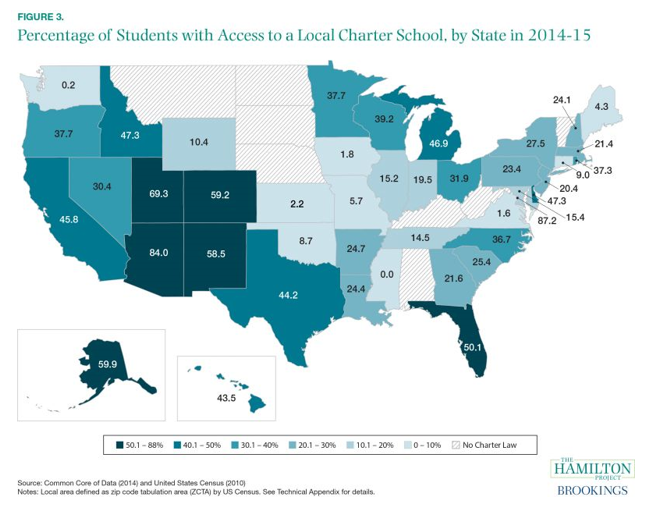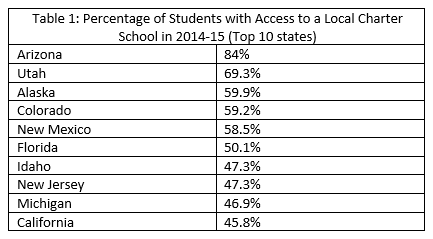
The Hamilton Project, launched in 2006 as an economic policy initiative of the Brookings Institution, calculated the percentage of K-12 students by state with one or more charter schools operating in their zip code during the 2014-15 school year. The top 10 states:

Making sense of the numbers: The Brookings access calculation is a useful but imperfect measure of choice. A charter school operating within a child’s zip code but with a long wait list is not equivalent to one with available seats, for instance. With the nation’s largest statewide charter sector, many Arizona zip codes will have multiple charter schools. Meanwhile, half of Alaska’s population lives in a single metro area (Anchorage), meaning a relatively small number of schools can reach a relatively large ratio of students.
Western states make up 7 of the top 10, and the entirety of the top 5, on the Hamilton list. This may be reflective of factors such as relatively rapid student population growth as well as political culture.
Keep in mind that the first charter school opened in Minnesota in 1991. Twenty-three years later, charters appeared largely contained in their state of origin, with only 37.7% of students having access to a charter in their zip code.
Digging deeper: An updated Hamilton calculation paired with data about open enrollment and access to private schools would provide a more complete picture of opportunity by state. Many have highly constrained open enrollment opportunities while others have near universal district participation. Lawmakers in a number of states (Arizona, Florida, Indiana, North Carolina, Ohio and Wisconsin) have created robust policies to allow disadvantaged student groups to choose private schools on a statewide basis in addition to numerous other opportunities.
State charter and private choice policies of enough strength and reach to encourage suburban district schools to change their open enrollment practices probably can still be counted on the digits of a single hand. I’ll put the over/under at Arizona, Florida and Indiana but I’m open to challenge on this point and I see you North Carolina. Keep it up. Note that charter and private choice policies strongly focused upon urban districts have undeniable value but a limited ability to throw down suburban drawbridges.
Conclusion: Suburban district schools will certainly not be every student’s cup of tea, but their participation increases opportunity and competition considerably. A school system in which urban families have the power to access schools of all types should be a central goal of the choice movement. Urban charter schools are necessary but not sufficient to achieve this goal.


